AUDI A3 2015 Owners Manual
Manufacturer: AUDI, Model Year: 2015, Model line: A3, Model: AUDI A3 2015Pages: 288, PDF Size: 71.46 MB
Page 171 of 288
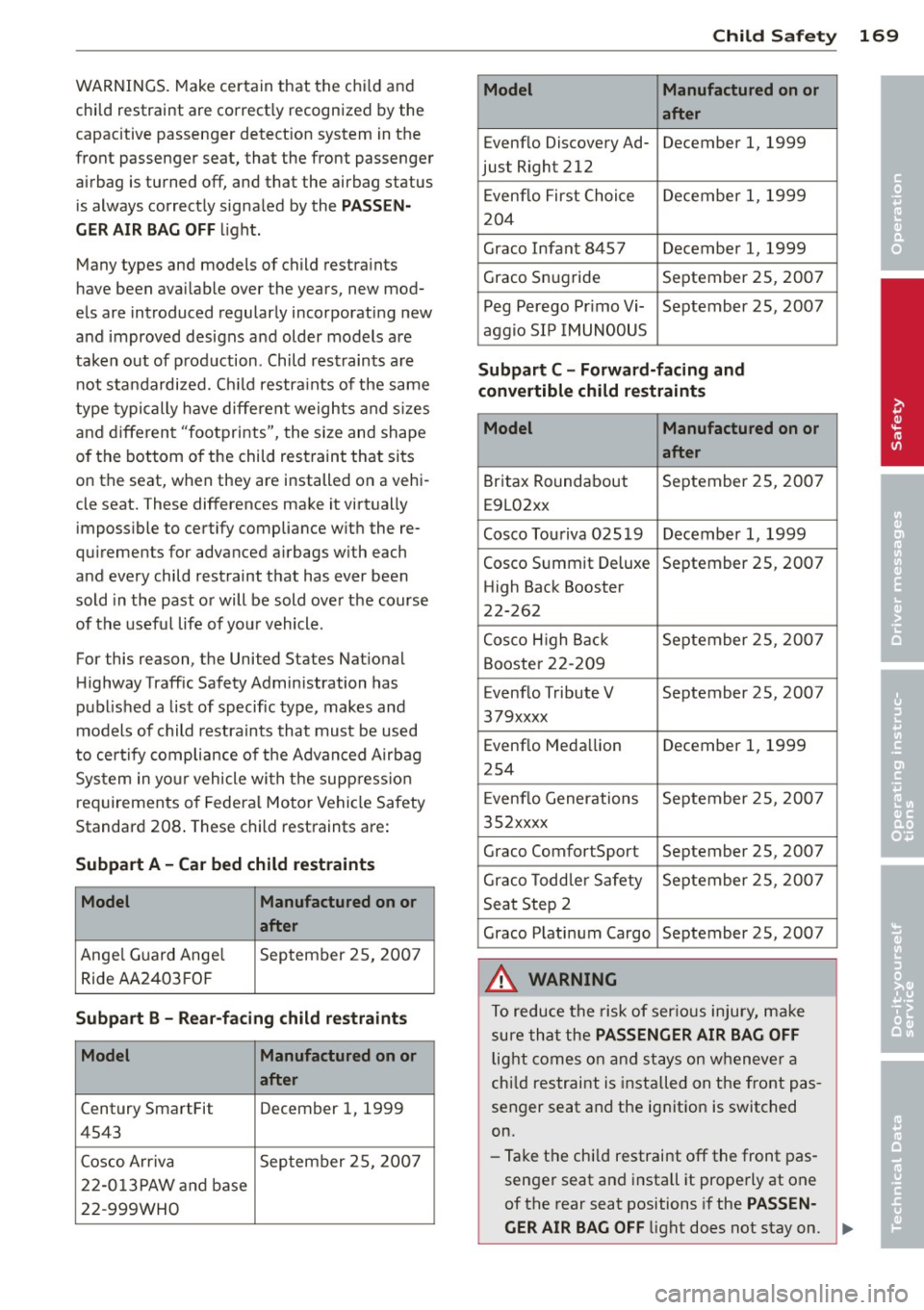
WARNINGS. Make certain that the chi ld and
chi ld restraint are correct ly recognized by the
capacitive passenger detect ion system in the
front passenger seat, that the front passenger
airbag is turned
off, and that the airbag status
is always correct ly signaled by the
PAS SEN
GER AIR BAG OFF
light .
Many types and models of child restra ints
have been ava ilable over the years, new mod
e ls are introduced regular ly incorporating new
and improved designs and older models are
taken out of production . Child restraints are
not standardized. Ch ild restra ints of the same
type typically have different we ights and s izes
and d ifferent "footprints", the size and shape
of the bottom of the child restraint that sits
on the seat, when they are installed on a vehi
cle seat. These differences make it virtually imposs ible to certify compliance w ith the re
qu irements for advanced a irbags with each
and every child restraint that has ever been
sold in the past or will be sold over the course
of the useful life of your vehicle.
For this reason, the United States National
H ighway Traffic Safety Administration has
published a list of specific type, makes and
models of child restraints that must be used
to certify compliance of the Advanced Airbag
System in your vehicle with the supp ress io n
requirements of Federa l Motor Vehicle Safety
Standard 208 . These child restraints are:
Subpart A -Ca r bed child rest raints
Model Manufactured on or
after
Ange l Guard Ange l September 25, 200 7
Ride AA2403 FOF
Subpart B -Re ar-f a cing child re stra ints
Model Manufactured on or
after
Century SmartFit December 1, 1999
4543
Cosco Arriva September 25, 2007
22-013PAW and base
22-999WHO
Child Sa fet y 169
Model Manufactured on or
after
Evenflo Discovery Ad- December 1, 1999
just Right 212
E venflo First Choice December 1, 1999
204
Graco Infant 8457 December 1, 1999
Graco Snug ride September 25, 2007 Peg Perego Pr imo Vi- September 25, 2007
aggio SIP IMUNOOUS
Subpart C -Forw ard-facing an d
convertible child restraint s
Mod el Manufactu
red on or
after
Britax Roundabout September 25, 2007
E9L02xx
Cosco Touriva 025 19 December 1, 1999
Cosco Summit Deluxe September 25, 2007
High Back Booster
22-262
Cosco H igh Back September 25, 2007
Booster 22-209
Evenflo Tribute V September 25, 2007
379xxxx
Evenf lo Meda llion December 1, 1999
254
E venflo Generations September 25, 2007
352xxxx
Graco ComfortSport September 25, 2007
Graco Todd ler Safety September 25, 2007
Seat Step 2
Graco Platinum Cargo September 25, 2007
A WARNING
To reduce the risk of ser ious injury, make
sure that the
PA SSENGER AIR BAG OFF
light comes on and stays on whenever a
chi ld restraint is installed on the front pas
senger seat and the ignition is switched
on.
- Take the child restraint
off the front pas
senger seat and install it properly at one
of the rear seat positions if the
PASS EN-
GER AI R BA G OFF
light does not stay on. ~
•
•
•
Page 172 of 288
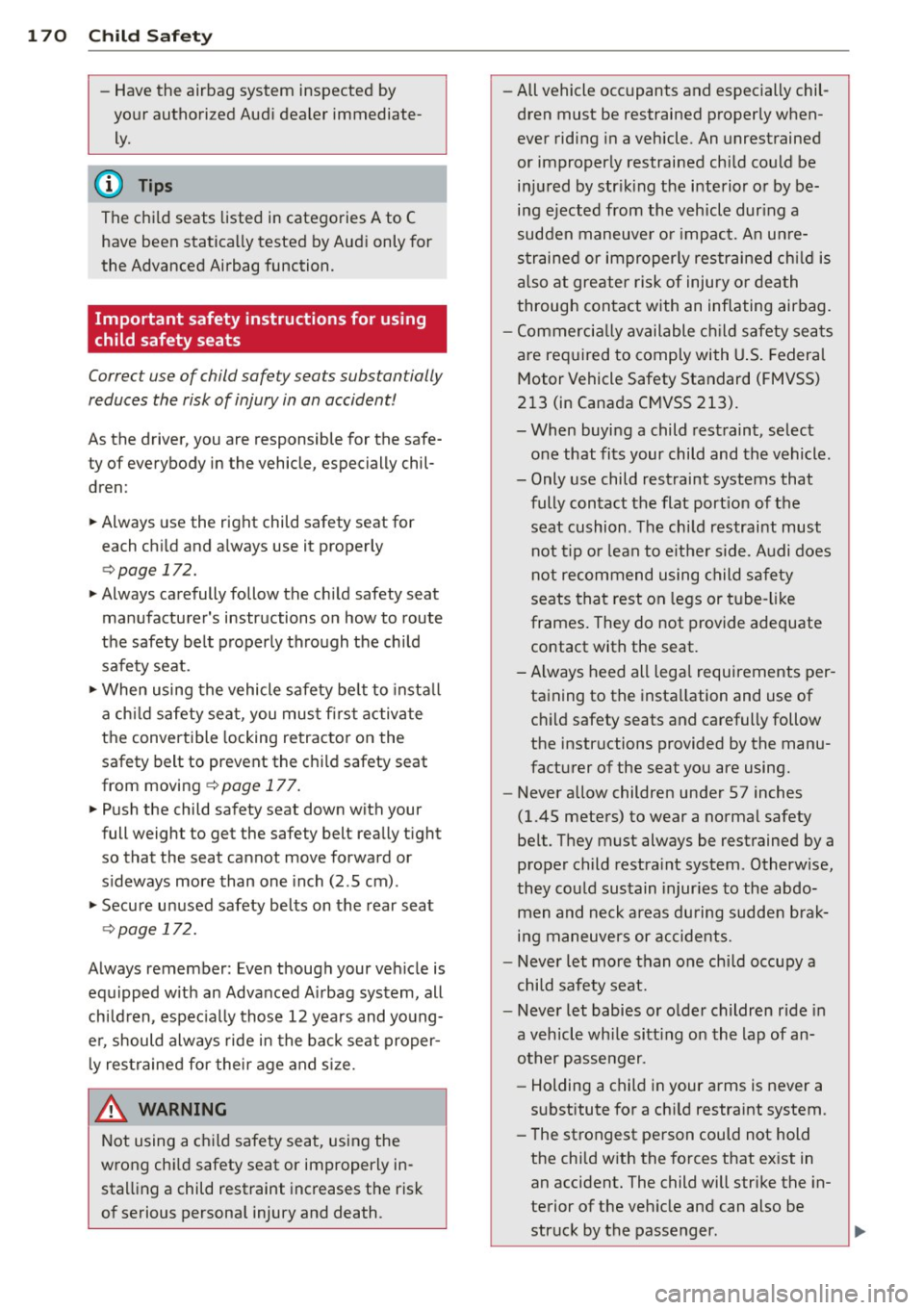
1 70 Child Safety
-Have the airbag system inspected by
your authorized Audi dealer immediate
ly.
The child seats listed in categories A to C have been statically tested by Audi only for
the Advanced Airbag function.
Important safety instructions for using
child safety seats
Correc t use of child safety seats substantially
reduces the risk of injury in an accident!
As the driver, you are responsible for the safe
ty of everybody in the vehicle, especially chil
dren :
• Always use the right child safety seat for
each child and always use it properly
c:> page 172.
• Always carefully follow the child safety seat
manufacturer's instructions on how to route
the safety belt properly through the child
safety seat.
• When using the vehicle safety belt to install
a child safety seat, you must first activate
the convertible locking retractor on the
safety belt to prevent the child safety seat
from moving
cc> page 177.
• Push the child safety seat down with your
full weight to get the safety belt really tight so that the seat cannot move forward or
sideways more than one inch (2.5 cm) .
• Secure unused safety belts on the rear seat
c:>page 172.
Always remember: Even though your vehicle is
equipped with an Advanced Airbag system, all
children , especially those 12 years and young
er, should always ride in the back seat proper
ly restrained for their age and size.
.&_ WARNING
Not using a child safety seat, using the
wrong child safety seat or improperly in stalling a child restraint increases the risk
of serious personal injury and death . -
-All vehicle occupants and especially chil
dren must be restrained properly when
ever riding in a vehicle. An unrestrained
or improperly restrained child could be
injured by striking the interior or by be
ing ejected from the vehicle during a
sudden maneuver or impact. An unre
strained or improperly restrained child is
also at greater risk of injury or death
through contact with an inflating airbag.
- Commercially available child safety seats
are required to comply with U.S. Federal
Motor Vehicle Safety Standard (FMVSS)
213 (in Canada CMVSS 213).
- When buying a child restraint, select one that fits your child and the vehicle.
- Only use child restraint systems that fully contact the flat portion of the seat cushion . The child restraint must
not tip or lean to either side . Audi does
not recommend using child safety
seats that rest on legs or tube-like
frames. They do not provide adequate
contact with the seat.
- Always heed all legal requirements per
taining to the installation and use of
child safety seats and carefully follow
the instructions provided by the manu
facturer of the seat you are using.
- Never allow children under 57 inches
(1.45 meters) to wear a normal safety
belt. They must always be restrained by a
proper child restraint system . Otherwise,
they could sustain injuries to the abdo men and neck areas during sudden brak
ing maneuvers or accidents.
- Never let more than one child occupy a
child safety seat.
- Never let babies or older children ride in
a vehicle while sitting on the lap of an
other passenger .
- Holding a child in your arms is never a
substitute for a child restraint system .
- The strongest person could not hold
the child with the forces that exist in
an accident. The child will strike the in
terior of the vehicle and can also be struck by the passenger.
Page 173 of 288

-The child and the passenger can also
injure each other in an accident .
- Never install rear-facing child safety
seats or infant carriers on the front pas
senger seat. A child will be seriously in
jured and can be killed when the passen ger airbag inflates - even with an Ad
vanced Airbag System.
- The inflating airbag will hit the child
safety seat or infant carrier with great
force and will smash the child safety seat
and child against the backrest, center
armrest, door or roof.
- Always install rear-facing child safety
seats or infant carriers on the rear seat.
- Forward-facing child safety seats instal
led on the front passenger's seat can in
terfere with the airbag when it inflates
and cause serious injury to the child. Al
ways install forward-facing child safety
seats on the rear seat.
- If exceptional circumstances require the
use of a forward-facing child restraint on
the front passenger's seat, the child's
safety and well-being require that the
following special precautions be taken:
- Make sure the forward-facing seat has
been designed and certified by its man
ufacturer for use on a front seat with a
passenger front and side airbag.
-Always carefully follow the manufac
turer's instructions provided with the
child safety seat or carrier.
- Always move the front passenger seat
into the rearmost position of the pas
senger seat's fore and aft adjustment
range, and as far away from the airbag
as possible before installing the child
restraint.
- Always make sure that nothing pre
vents the front passenger's seat from
being moved to the rearmost position
in its fore and aft adjustment range .
- Always make sure that the backrest is
in the upright position.
- Never place or use any electrical device
(such as a laptop, CD player, electronic
games device, power inverter or seat
Child Safety 1 71
heater for child seats) on the front pas
senger seat if the device is connected
to the 12-volt socket or the cigarette lighter socket.
- If a seat heater has been retrofitted or
otherwise added to the front passen
ger seat, never install any child re
straint system on this seat.
- Make sure that there are no wet objects
(such as a wet towel) and no water or
other liquids on the front passenger
seat cushion .
- Never place objects on the seat (such
as a laptop, CD player, electronic games device, power inverter or seat
heater for child seats). These may in
fluence the electrical capacitance
measured by the capacitive passenger
detection system and can also fly
around in an accident and cause serious
personal injury.
- Always buckle the child safety seat firmly
in place even if a child is not sitting in it.
A loose child safety seat can fly around
during a sudden stop or in a collision .
- Always read and heed all WARNINGS
whenever using a child restrained in ave
hicle is being used
<=> page 131, Safety
belts,
¢ page 140, Airbag system and
¢ page 166, Child Safety .
A WARNING
To reduce the risk of serious injury, make
sure that the
PASSENGER AIR BAG OFF
light comes on and stays on whenever a
child restraint is installed on the front pas
senger seat and the ignition is switched
on.
- Take the child restraint off the front pas senger seat and install it properly at one
of the rear seat positions if the
PASSEN
GER AIR BAG OFF
light does not stay on.
- Have the airbag system inspected by
your authorized Audi dealer immediate
ly . •
•
•
Page 174 of 288
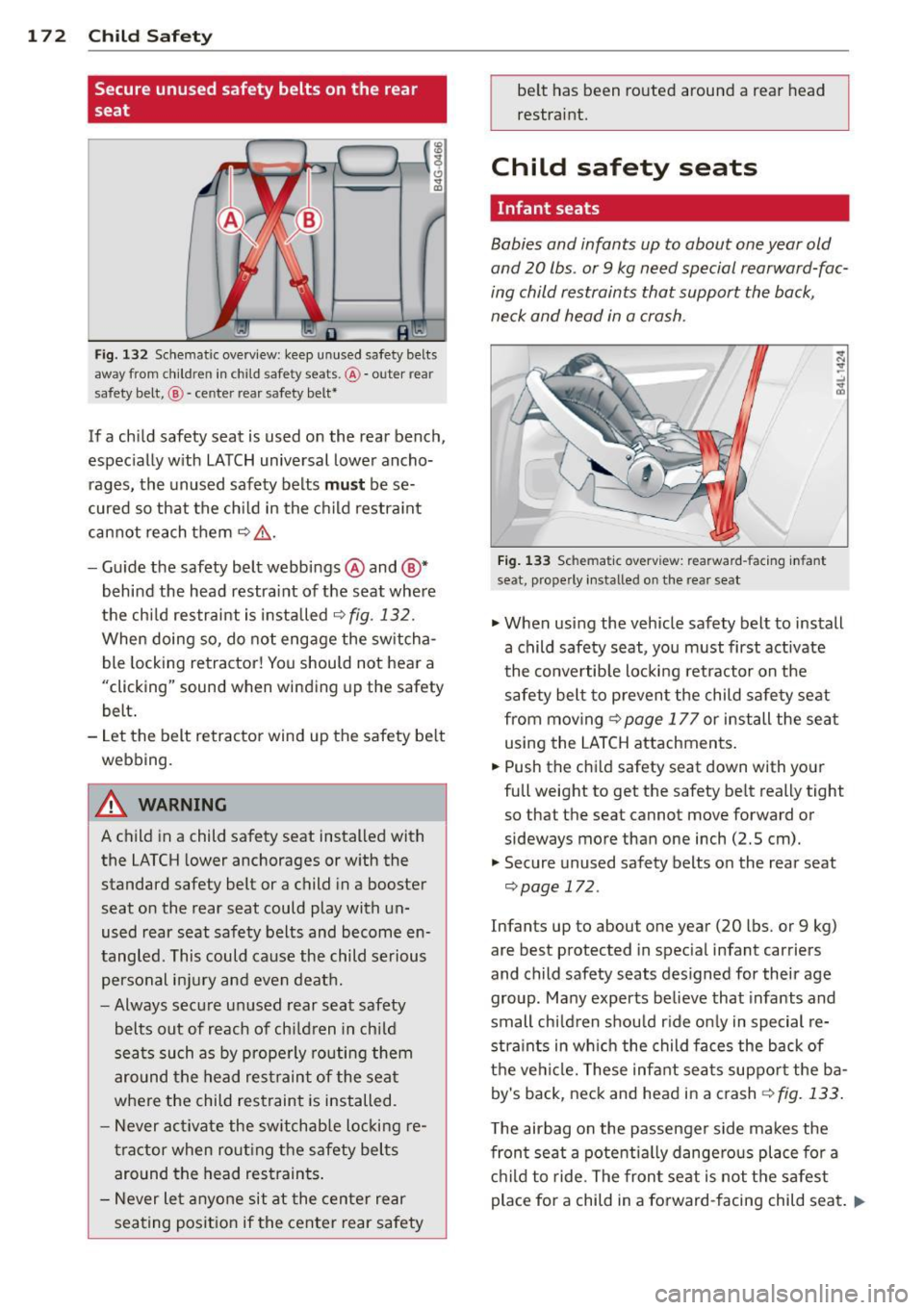
172 Child Safety
Secure unused safety belts on the rear
seat
Fig . 132 Schematic overview: keep unused safety belts
away from children in child safety seats.@-outer rear
safety belt,
® -center rear safety belr
If a child safety seat is used on the rear bench,
especially with LATCH universal lower ancho
rages, the unused safety belts
must be se
cured so that the child in the child restraint
cannot reach them¢,&..
- Guide the safety belt webbings @and
®*
behind the head restraint of the seat where
the child restraint is installed
¢fig . 132.
When doing so, do not engage the switcha
ble locking retractor! You should not hear a
"clicking" sound when winding up the safety
belt.
- Let the belt retractor wind up the safety belt webbing.
A WARNING
A child in a child safety seat installed with
the LATCH lower anchorages or with the
standard safety belt or a child in a booster
seat on the rear seat could play with un
used rear seat safety belts and become en
tangled. This could cause the child serious personal injury and even death.
-Always secure unused rear seat safety
belts out of reach of children in child
seats such as by properly routing them
around the head restraint of the seat
where the child restraint is installed.
- Never activate the switchable locking re
tractor when routing the safety belts
around the head restraints.
- Never let anyone sit at the center rear
seating position if the center rear safety belt has been routed around a rear head
restraint.
Child safety seats
Infant seats
Babies and infants up to about one year old
and 20 lbs . or
9 kg need special rearward-fac
ing child restraints that support the back,
neck and head in a crash.
Fig. 133 Schemat ic overview: rearward -facing in fant
seat, properly installed on the rear seat
.,. When using the vehicle safety belt to install
a child safety seat, you must first activate
the convertible locking retractor on the
safety belt to prevent the child safety seat
from moving
¢page 177 or install the seat
using the LATCH attachments.
.,. Push the child safety seat down with your
full weight to get the safety belt really tight
so that the seat cannot move forward or
sideways more than one inch (2.5 cm).
.,. Secure unused safety belts on the rear seat
¢page 172.
Infants up to about one year (20 lbs. or 9 kg)
are best protected in special infant carriers
and child safety seats designed for their age
group. Many experts believe that infants and
small children should ride only in special re
straints in which the child faces the back of
the vehicle. These infant seats support the ba
by's back, neck and head in a crash¢
fig. 133.
The airbag on the passenger side makes the
front seat a potentially dangerous place for a
child to ride . The front seat is not the safest
place for a child in a forward-facing child seat . ..,.
Page 175 of 288
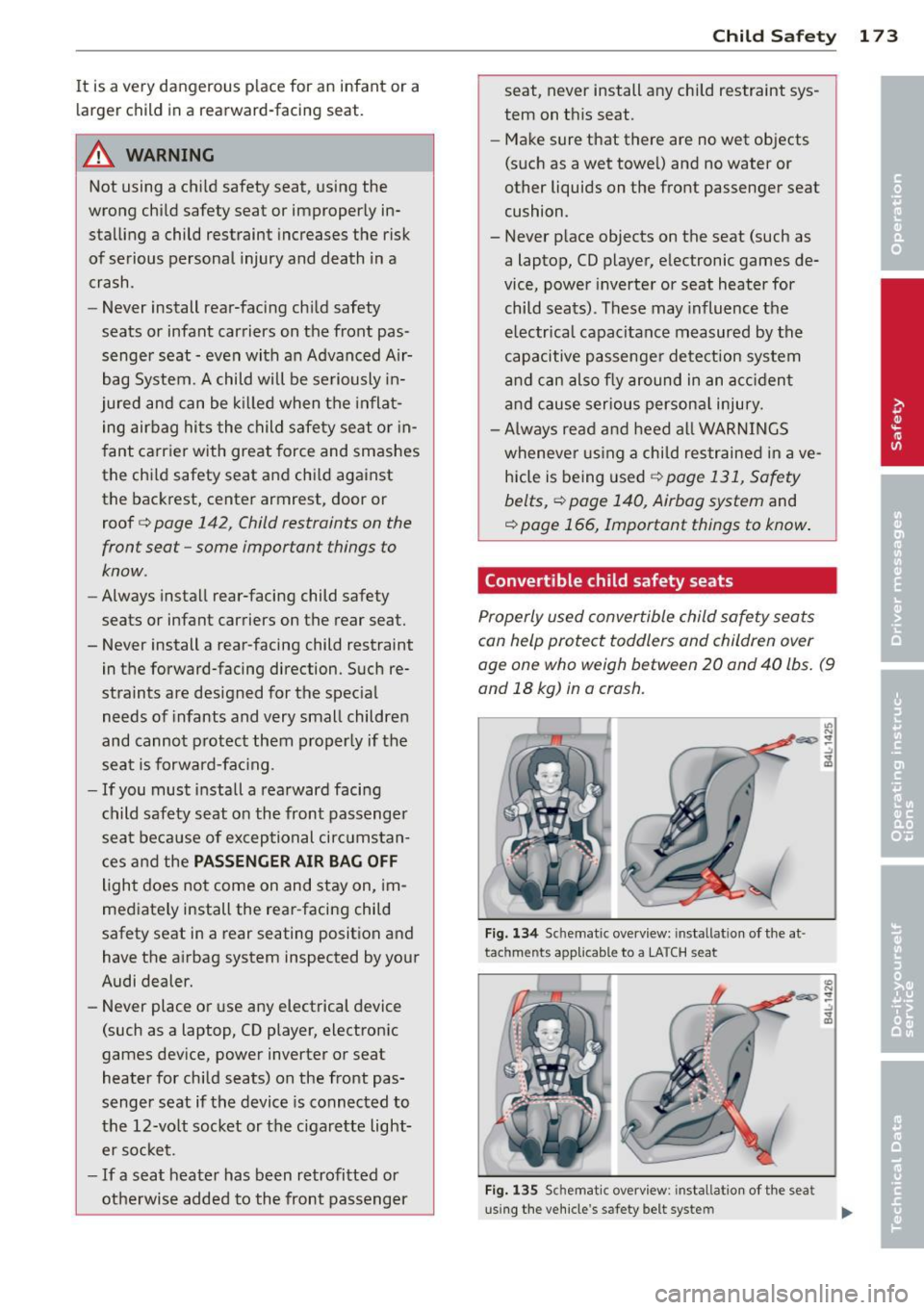
It is a very dangerous place for an infant or a
la rger child in a rearward-facing seat.
A WARNING
Not using a child safety seat, using the
wrong child safety seat or improperly in stalling a child restraint increases the risk
of serious personal injury and death in a
crash.
- Never install rear-facing child safety
seats or infant carriers on the front pas
senger seat -even with an Advanced Air
bag System. A child will be seriously in
jured and can be killed when the inflat
ing airbag hits the child safety seat or in
fant carrier with great force and smashes
the child safety seat and child against
the backrest, center armrest, door or
roof
c::> page 142, Child restraints on the
front seat -some important things to
know.
- Always install rear-facing child safety
seats or infant carriers on the rear seat.
- Never install a rear-facing child restraint
in the forward-facing direction. Such re
straints are designed for the special
needs of infants and very small children
and cannot protect them properly if the
seat is forward-facing .
-If you must install a rearward facing
child safety seat on the front passenger
seat because of exceptional circumstan
ces and the
PASSENGER AIR BAG OFF
light does not come on and stay on, im
mediately install the rear-facing child
safety seat in a rear seating position and have the airbag system inspected by your
Audi dealer.
- Never place or use any electrical device
(such as a laptop, CD player, electronic
games device, power inverter or seat
heater for child seats) on the front pas
senger seat if the device is connected to
the 12-volt socket or the cigarette light
er socket.
- If a seat heater has been retrofitted or
otherwise added to the front passenger
Child Safety 173
seat, never install any child restraint sys
tem on this seat.
- Make sure that there are no wet objects
(such as a wet towel) and no water or
other liquids on the front passenger seat
cushion.
- Never place objects on the seat (such as
a laptop, CD player, electronic games de
vice, power inverter or seat heater for
child seats). These may influence the
electrical capacitance measured by the
capacitive passenger detection system
and can also fly around in an accident
and cause serious personal injury.
- Always read and heed all WARNINGS
whenever using a child restrained in ave
hicle is being used
c::> page 131, Safety
belts,
c::> page 140, Airbag system and
c::> page 166, Important things to know.
Convertible child safety seats
Properly used convertible child safety seats
can help protect toddlers and children over
age one who weigh between 20 and 40 lbs. (9
and 18 kg) in a crash.
Fig. 134 Schematic overview: installat ion of the at
tac hme nts applicab le to a LA T CH seat
Fig. 135 Sc hemat ic overv iew : installatio n of the seat
using the vehicle 's safety belt syste m
I),,
Page 176 of 288
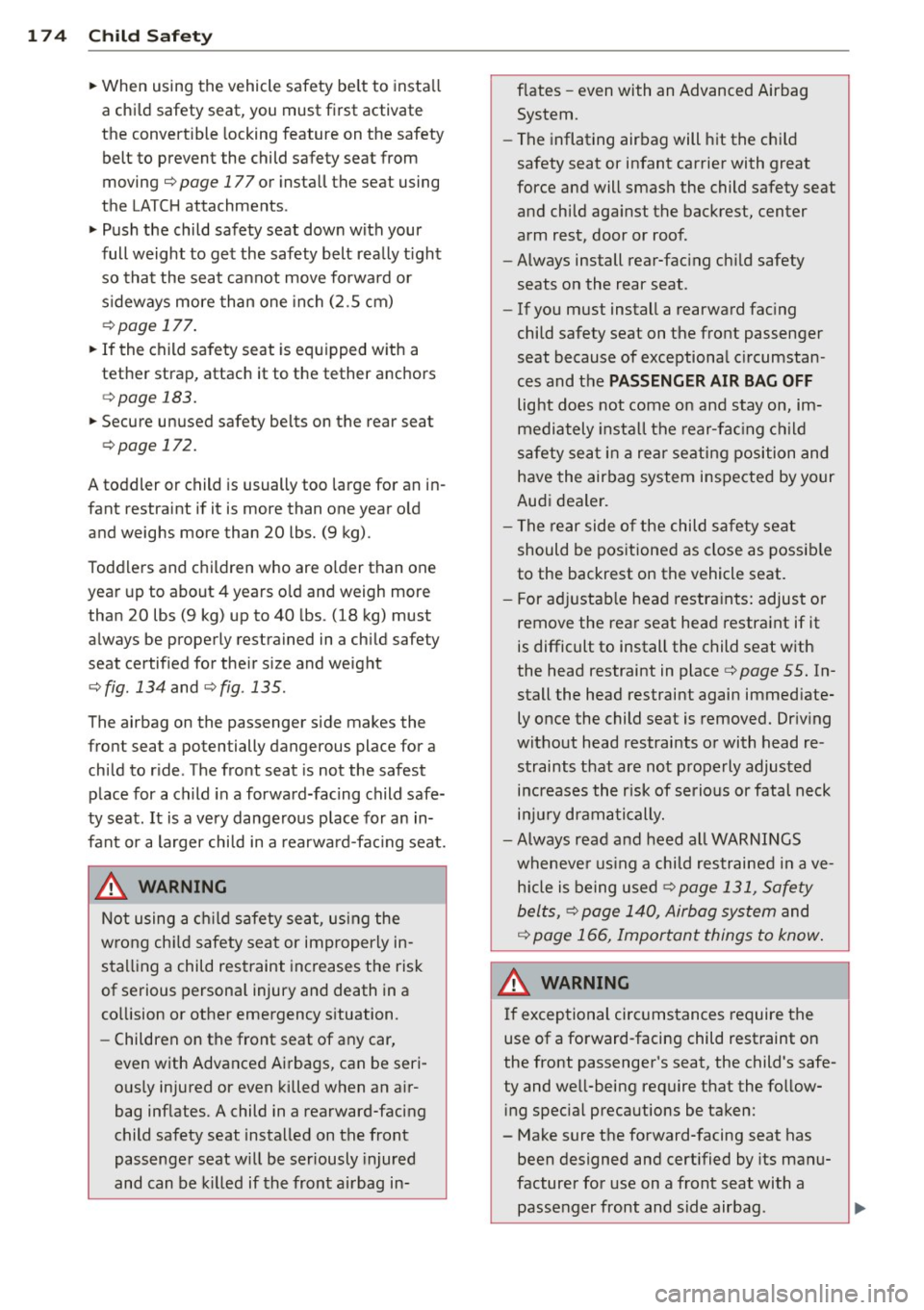
174 Child Safety
• When using the vehicle safety belt to install
a child safety seat, you must first activate
the convertible locking feature on the safety
belt to prevent the child safety seat from
moving
c::;, page 177 or install the seat using
the LATCH attachments .
• Push the child safety seat down with your
full weight to get the safety belt really tight so that the seat cannot move forward or
sideways more than one inch (2.5 cm)
c::;, page 177.
• If the child safety seat is equipped with a
tether strap, attach it to the tether anchors
c::;, page 183.
• Secure unused safety belts on the rear seat
c::;, page 172.
A toddler or child is usually too large for an in
fant restraint if it is more than one year old
and weighs more than 20 lbs. (9 kg) .
Toddlers and children who are older than one
year up to about 4 years old and weigh more
than 20 lbs (9 kg) up to 40 lbs. (18 kg) must
always be properly restrained in a child safety
seat certified for their size and weight
c::;, fig. 134 and c::;, fig . 135.
The airbag on the passenger side makes the
front seat a poten tially dangerous place for a
child to ride . The front seat is not the safest
place for a child in a forward-facing child safe
ty seat.
It is a very dangerous place for an in
fant or a larger child in a rearward-facing seat.
A WARNING
Not using a child safety seat, using the
wrong child safety seat or improperly in
stalling a child restraint increases the risk
of serious personal injury and death in a
collision or other emergency situation.
- Children on the front seat of any car,
even with Advanced Airbags, can be seri
ously injured or even killed when an air
bag inflates. A child in a rearward-facing
child safety seat installed on the front
passenger seat will be seriously injured
and can be killed if the front airbag in-
-
flates -even with an Advanced Airbag
System .
- The inflating airbag will hit the child
safety seat or infant carrier with great
force and will smash the child safety seat
and child against the backrest, center
arm rest, door or roof .
- Always install rear-facing child safety
seats on the rear seat .
- If you must install a rearward facing
child safety seat on the front passenger
seat because of exceptional circumstan
ces and the
PASSENGER AIR BAG OFF
light does not come on and stay on, im
mediately install the rear-facing child
safety seat in a rear seating position and
have the airbag system inspected by your
Audi dealer.
- The rear side of the child safety seat
should be positioned as close as possible
to the backrest on the vehicle seat.
- For adjustable head restraints: adjust or
remove the rear seat head restraint if it
is difficult to install the child seat with
the head restraint in place
c::;, page 55. In
stall the head restraint again immediate ly once the child seat is removed. Driving
without head restraints or with head re straints that are not properly adjusted
increases the risk of serious or fatal neck
injury dramatically.
- Always read and heed all WARNINGS
whenever using a child restrained in ave
hicle is being used
¢page 131, Safety
belts, c::;, page 140, Airbag system
and
c::;, page 166, Important things to know.
A WARNING
-
If exceptional circumstances require the
use of a forward-facing child restraint on
the front passenger's seat, the child's safe
ty and well-being require that the follow
ing special precautions be taken:
- Make sure the forward-facing seat has been designed and certified by its manu
facturer for use on a front seat with a passenger front and side airbag.
Page 177 of 288
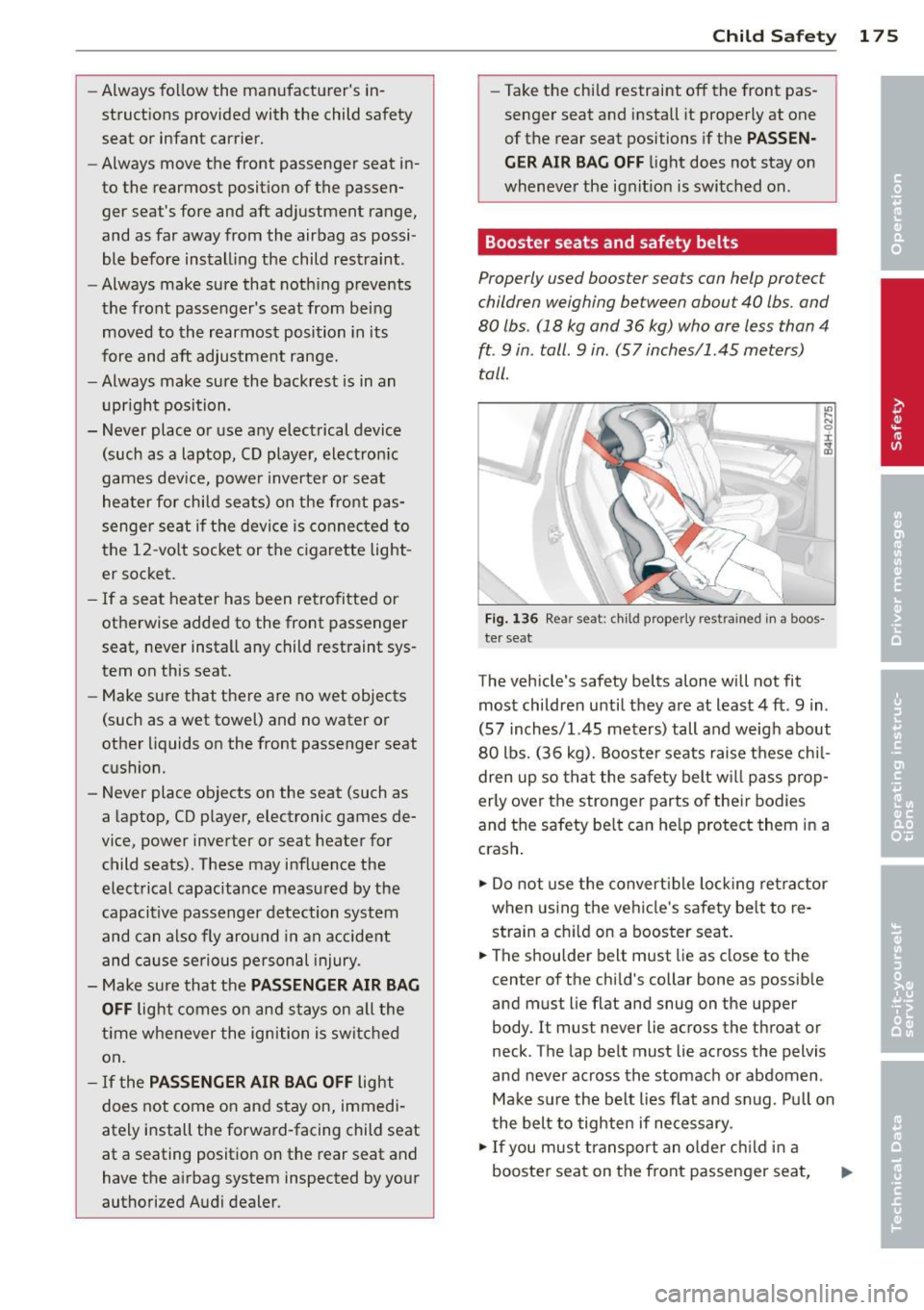
-Always follow the manufacturer's in
struct ions provided with the child safety
seat or infant carrier.
- Always m ove the front passenger seat in
to the rearmost position of the passen ger seat's f ore and aft adjustment range,
and as far away from the airbag as possi
ble before install ing the child restraint.
- Always make sure that noth ing prevents
the front passenger's seat from being moved to the rearmost position in its
fore and aft adjustment range.
- Always make sure the backrest is in an
upr ight position .
- Never place o r use any electrical device
(such as a laptop, CD player, electron ic
games dev ice, power inverter o r seat
heater for child se ats ) on the fr ont pas
senger se at if the device is connected to
the 12-vo lt socket or the cigarette light
er socket.
- If a seat heater has been retrofitted or
otherwise added to the front passenger
seat, never install any child restraint sys
tem on this seat.
- Make sure that there are no wet objects
(such as a wet towel) and no water or
other liquids on the front passenger seat
cushion.
- Never place objects on the seat (such as
a laptop, CD player, electronic games de
vice, power inverter or seat heate r for
child seats). These may influence the
elect rical capacitance measu red by the
capacit ive passenger detection system
and can a lso fly aro und in an accident
a nd cau se se riou s person al injury.
- Make sure that the
PASSENGER AIR BAG
OFF
lig ht comes on an d stays on all the
t ime whenever the ignition is switched
on .
- If the
PASSENGER AIR BAG OFF light
does not come on and s tay on, immedi
ately install the forward-facing child seat
at a seating posit ion on the rear seat and
have the a irbag system inspected by your
authorized Audi dealer. Child S
afety 175
- Ta ke the chi ld restraint off the front pas
senger seat and install it properly at one
of the rear seat positions if the
PASSEN
GER AIR BAG OFF
li ght does not stay on
whenever the ignit ion is switched on.
Booster seats and safety belts
Properly used booster seats can help protect
children weighing between about 40 lbs. and
80 lbs . (18 kg and 36 kg) who are less than 4
ft. 9 in . tall. 9 in . (57 inches/1 .45 meters)
tall.
F ig. 1 36 Rea r seat : ch ild p roperly res trained in a boos
ter seat
The vehicle's safety belts alone will not fit
most children until they are at leas t 4 ft . 9 in .
(57 inches/1.45 meters) tall and weig h about
80 lbs. (36 kg). Booster seats rai se t hese chi l
dren up so that the safety belt w ill pass prop
erly over the stronge r parts of the ir bodies
and t he safety be lt can he lp pro tect them in a
c rash .
.,. Do not use the convert ible lock ing retractor
when using the veh icle's safety be lt to re
strain a ch ild on a booster seat .
.. The s houlde r belt must lie as close to the
center of the chi ld's collar bone as possib le
and must lie flat and snug on the upper
body. It must never lie across the throat or
neck . The lap be lt must lie across the pelvis
and never ac ross the stomach or abdomen .
Mak e su re the be lt lies flat and sn ug. P ull on
the belt to tighten if necessary .
.,. If you must tra nsport an older c hild in a
booste r seat on the front passenger sea t, .._
Page 178 of 288
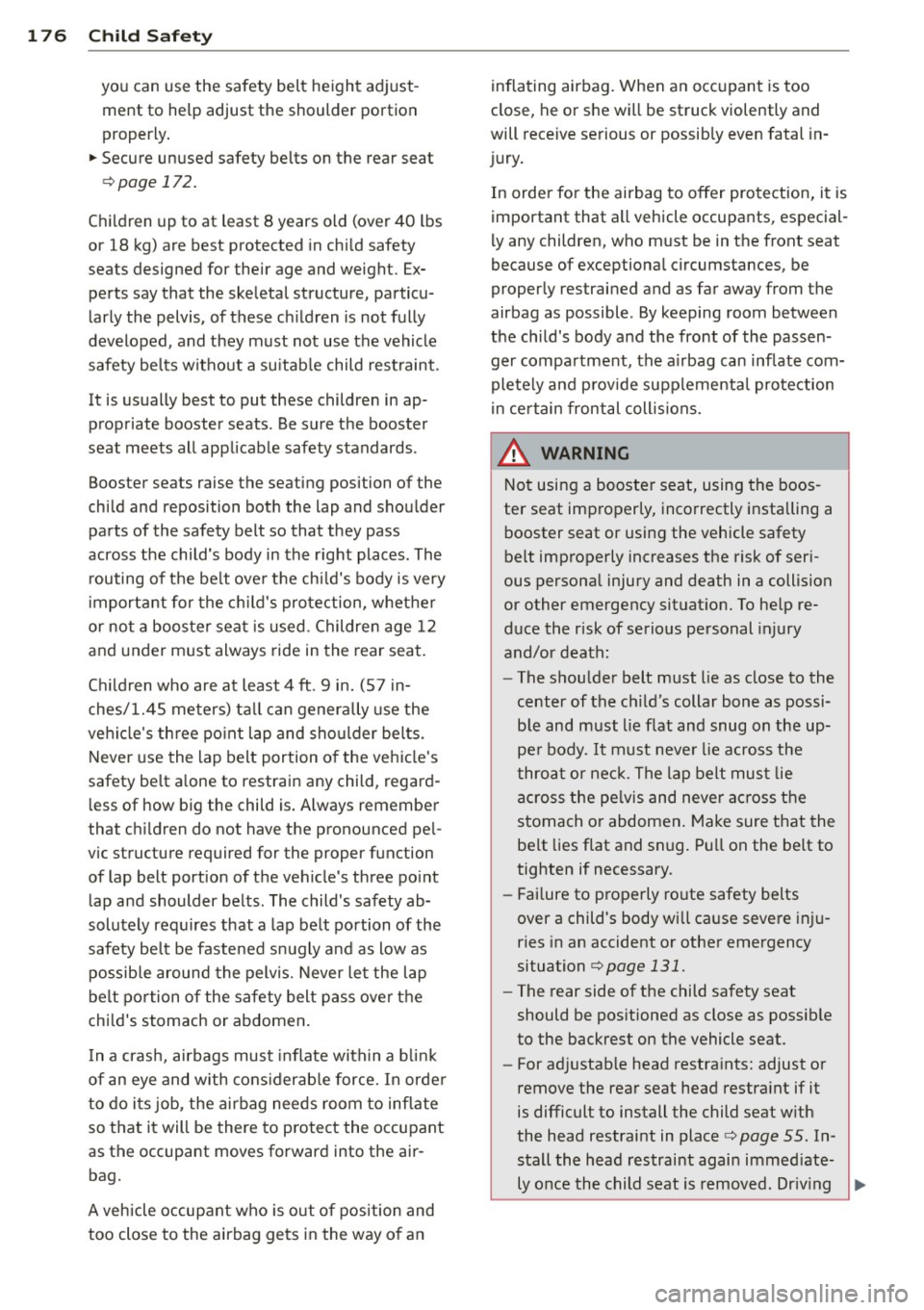
176 Child Saf ety
you can use the safety belt he ight adjust
ment to help adjust the shoulder portion
properly .
• Secure unused safety belts on the rear seat
¢ page 172.
Children up to at least 8 years old (over 40 lbs
or 18 kg) are best protected in chi ld safety
seats designed for their age and weight. Ex
perts say that the skeletal structure, particu
larly the pelvis, of these ch ildren is not fully
developed, and they must not use the vehicle
safety belts without a su itab le child restraint .
It is usually best to put these children in ap propriate booster seats. Be sure the booster
seat meets all applicable safety standards .
Booster seats raise the seating position of the
child and reposition both the lap and shoulder parts of the safety belt so that they pass
across the child's body in the right places. The routing of the belt over the ch ild's body is very
important for the child's protection, whethe r
or not a booster seat is used . Children age 12
and under must always ride in the rear seat.
C hil dren who are at least 4
ft. 9 in. (57 in
ches/1.45 meters) ta ll can generally use the
vehicle's th ree po int lap and shoulder be lts.
Never use the lap belt portion of the veh icle's
safety belt a lone to restrain any child, regard
less of how big the child is . Always remember
that ch ildren do not have the pronounced pe l
vic structure required for the proper function of lap belt portion of the vehicle's three po int
lap and shoulder belts. The child's safety ab
solutely requires that a lap belt portion of the
safety belt be fastened snugly and as low as possib le around the pelvis. Never let the lap
be lt portion of the safety belt pass over the
chi ld's stomach or abdomen.
I n a crash, airbags must inflate within a b link
of an eye and with cons iderab le force. In orde r
to do i ts job , the airbag needs room to inflate
so that it will be there to protect the occupant
as the occupant moves forward into the air bag.
A vehicle occupant who is o ut of position and
too close to the airbag ge ts i n the way o f an inflating airbag. When an occ
upant is too
close, he or she will be st ruck violently and
will rece ive serious or possib ly even fatal in
j ury.
In order for the airbag to offer protection, it is
important that a ll vehicle occupants, especial
l y any children, who m ust be in the front seat
because of exceptiona l circumstances, be
properly restrained and as far away from the
airbag as possible . By keeping room between
the ch ild's body and the front of the passen
ger compa rtment, the a irbag can inflate com
pletely and p rov ide supplementa l protection
i n certain frontal collisions.
A WARNING
N ot using a booste r seat, using the boos
ter seat improperly, incorrectly installing a booster seat or using the vehicle safety
belt improperly increases the risk of seri
ous persona l injury and death in a collision
or other emergency situat ion. To he lp re
duce the risk of serious personal injury
and/or death:
- The shou lder belt must lie as close to the
center of the ch ild's collar bone as possi
b le and must lie flat and snug on the up
pe r body.
It must neve r lie across the
throat or ne ck. The lap belt mus t lie
across the pe lvis and neve r ac ross the
stomach or abdomen . Make sure that the
be lt lies flat and snug. P ull on the belt to
tighten if necessary .
- Fai lure to p roperly ro ute safety belts
over a child's body will ca use seve re in ju
ries in an accident or other emergency
situation ¢
page 131.
-The rear side o f the child safety seat
should be pos itioned as close as possib le
to the backrest on the vehicle seat.
- For ad justab le head restraints: adjust or
remove the rear seat head restra int if it
is difficult to install the child seat w ith
the head restraint in place¢
page 55. In
stall the head restraint again immed iate-
ly once the child seat is removed. Dr iv ing
Ii),
Page 179 of 288
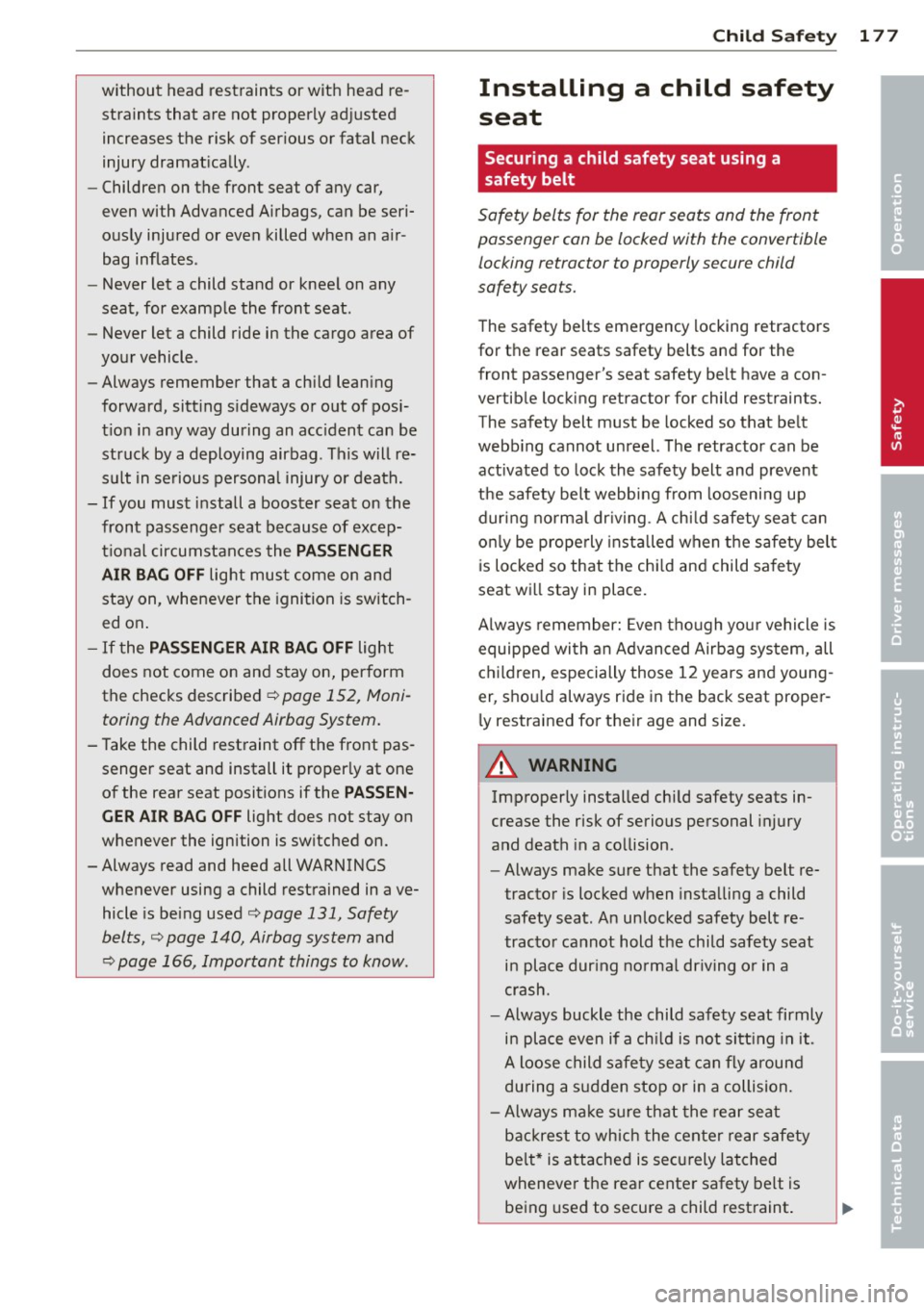
without head restraints or with head re
straints that are not pr operly ad justed
increases the risk of ser ious or fatal neck
injury dramat ically .
- Children on the front seat of any car,
even with Advanced A irbags, can be seri
ously injured or even killed when an a ir
bag inflates .
- Never let a child stand or knee l on any
seat, for example the front seat.
- Never let a child ride in the cargo area of
your vehicle .
- Always remember that a ch ild lean ing
forward, sitt ing s ideways o r out of posi
t ion i n any way during an acc ident can be
st ruck by a deploying airbag . This will re
s u lt in se rious personal injury or death.
- If you must install a booster seat on the
front passenger seat because of excep
tio nal circumstan ces the
PASSENGER
AIR BAG OFF
light must come on and
stay on, whenever the igni tion is switch
ed on .
-If the PASSENGER AIR BAG OFF light
does not come on and s tay on, per form
the checks described ¢
page 152, Moni
toring the Advanced Airbag System.
- Take the child rest raint off the front pas
senger seat and install it proper ly at one
of the rear seat positions if the
PASSEN
GER AIR BAG OFF
light does not stay on
whenever the ignition is switched on.
- Always read and heed all WARNINGS whenever using a child restrained in ave
hicle is bei ng used ¢
page 131 , Safety
belts, ¢ page 140, Airbag system
and
¢page 166, Important things to know .
Child Safet y 177
Installing a child safety
seat
Securing a child safety seat using a
safety belt
Safety belts for the rear seats and the front
passenger con be locked with the convertible locking retractor to properly secure child
safety sea ts.
T he safety belts emergency locking retractors
fo r the rear seats safety belts and for the
front passenger's seat safety belt have a con
vertib le locking retractor for child restraints.
The safety belt must be locked so that be lt
webb ing cannot unreel. The retractor can be
activated to loc k the safe ty belt and prevent
t h e safety be lt webb ing from looseni ng up
dur ing no rm al driv in g. A ch ild safety seat can
o nl y be prope rly installed w hen t he s afety bel t
is locked so that the chi ld and child sa fety
seat w ill stay in place.
A lways remember: Even tho ugh yo ur vehicle is
equipped wi th an A dvanced Airbag sys tem, all
c hi ldren, es pecially those 12 years and young
er, sho uld always r ide in the back seat proper
l y restra ined for t he ir age and size.
A WARNING
Im properly installed chi ld safety seats in
crease the risk of serious personal injury
a n d death in a co llision .
- Always make sure that the safety belt re
tractor is locked w hen insta lling a child
safety seat. An unlocked safety belt re
trac to r cannot hold the child safety seat
in place dur ing norma l dr iving o r in a
crash.
- Always buckle the child safe ty seat firmly
i n place even if a ch ild is not sitt ing in it.
A l oose child safe ty se at can fly aroun d
du ring a sudden stop or in a collision.
- Always ma ke sure tha t the rear seat
b ackrest to which the ce nter re ar safe ty
be lt * is attache d is se curely latched
wheneve r the rea r cente r safety belt is
be ing used to secure a child rest raint .
•
•
•
Page 180 of 288
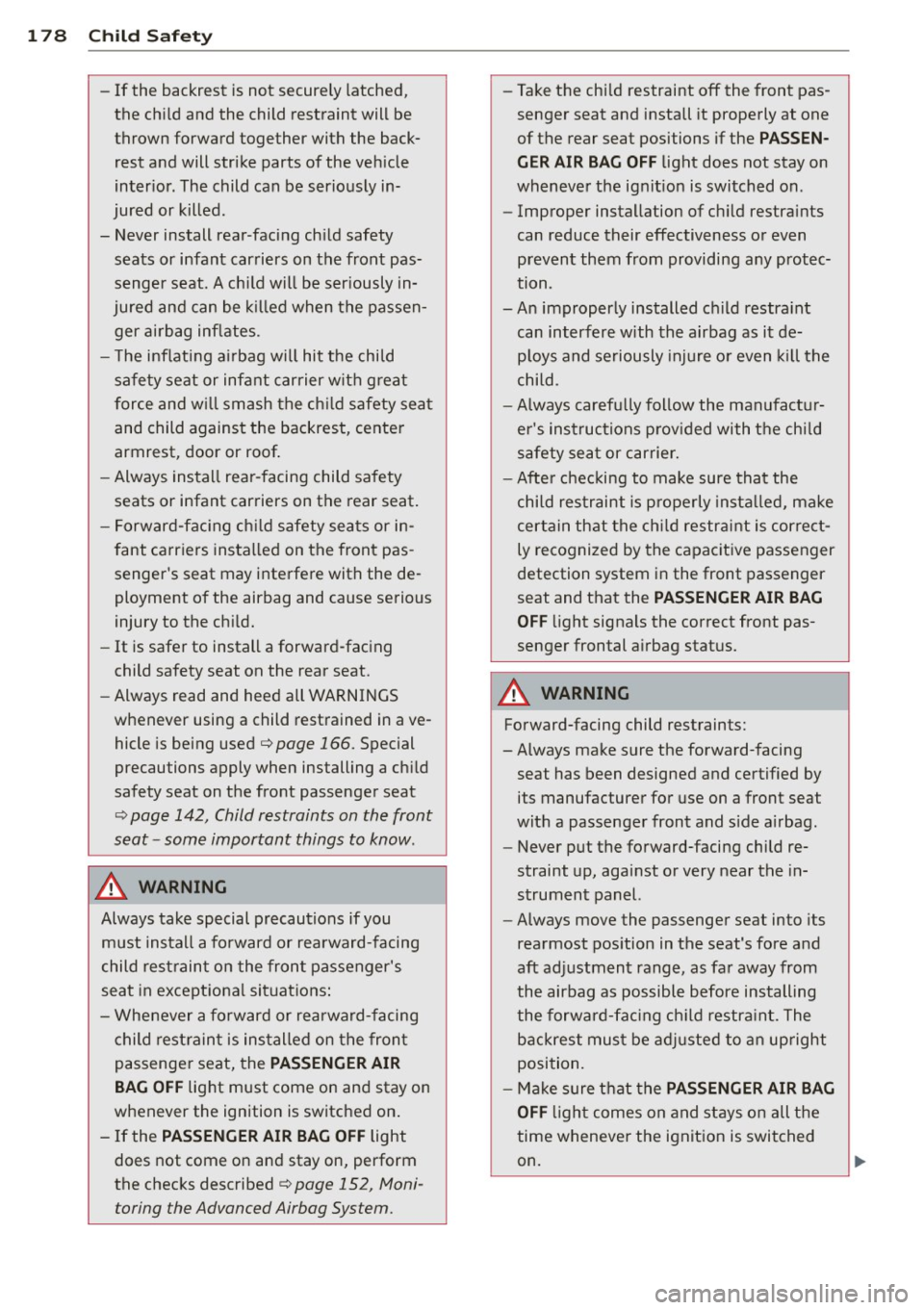
178 Child Safety
-If the backrest is not securely latched,
the child and the child restraint will be
thrown forward together with the back
rest and will strike parts of the vehicle
interior. The child can be seriously in
jured or killed.
- Never install rear -facing child safety
seats or infant carriers on the front pas
senger seat. A child will be seriously in
jured and can be killed when the passen ger airbag inflates.
- The inflating airbag will hit the child
safety seat or infant carrier with great
force and will smash the child safety seat
and child against the backrest, center
armrest, door or roof.
- Always install rear-facing child safety
seats or infant carriers on the rear seat.
- Forward-facing child safety seats or in
fant carriers installed on the front pas
senger's seat may interfere with the de
ployment of the airbag and cause serious
injury to the child.
- It is safer to install a forward-facing
child safety seat on the rear seat.
- Always read and heed all WARNINGS
whenever using a child restrained in ave
hicle is being used¢
page 166. Special
precautions apply when installing a child
safety seat on the front passenger seat
¢ page 142, Child restraints on the front
seat -some important things to know .
A WARNING
-
Always take special precautions if you
must install a forward or rearward-facing
child restraint on the front passenger's
seat in exceptional situations:
- Whenever a forward or rearward-facing
child restraint is installed on the front
passenger seat, the
PASSENGER AIR
BAG OFF
light must come on and stay on
whenever the ignition is switched on.
- If the
PASSENGER AIR BAG OFF light
does not come on and stay on, perform
the checks described ¢
page 152, Moni
toring the Advanced Airbag System.
- Take the child restraint off the front pas
senger seat and install it properly at one
of the rear seat positions if the
PASSEN
GER AIR BAG OFF
light does not stay on
whenever the ignition is switched on.
- Improper installation of child restraints
can reduce their effectiveness or even
prevent them from providing any protec
tion .
-An improperly installed child restraint can interfere with the airbag as it de
ploys and seriously injure or even kill the
child.
-Always carefully follow the manufactur
er's instructions provided with the child
safety seat or carrier.
- After checking to make sure that the
child restraint is properly installed, make
certain that the child restraint is correct ly recognized by the capacitive passenger
detection system in the front passenger
seat and that the
PASSENGER AIR BAG
OFF
light signals the correct front pas
senger frontal airbag status.
A WARNING
-Forward-facing child restraints:
- Always make sure the forward-facing seat has been designed and certified by
its manufacturer for use on a front seat
with a passenger front and side airbag.
- Never put the forward-facing child re
straint up, against or very near the in
strument panel.
- Always move the passenger seat into its
rearmost position in the seat's fore and
aft adjustment range, as far away from
the airbag as possible before installing
the forward-facing child restraint. The
backrest must be adjusted to an upright
position.
- Make sure that the
PASSENGER AIR BAG
OFF
light comes on and stays on all the
time whenever the ignition is switched
on.